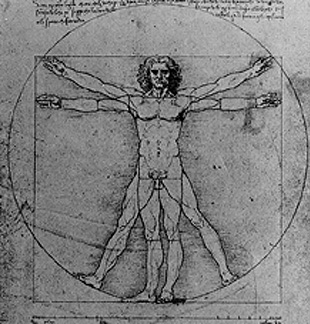|
–Vitruvius, the leading architect of Augustan Rome, propounded the remarkable notion that great and enduring works of architecture, and particularly of temples, were based on the proportions, one to another, of their various parts in almost exact correspondence to the way the parts of the human anatomy are proportionally related in the body of what Vitruvius called "a well-shaped man." He worked out these relationships in elaborate fractions and in detail; and fourteen and a half centuries later his outline of them served as the basis of an illustration by Leonardo da Vinci of a naked man, inscribed inside a square and a circle, with two sets of arms and of legs, and with the center of the image the man's navel. It has become a very familiar iconic device.
Vitruvius was painstaking in his demonstration that these ideal human proportions, admired not only when encountered in fellow-humans but in the greatest sculptures of ancient times, were the very proportions, recognized somehow unconsciously but kinesthetically and immediately, in those buildings that were most enduringly pleasing and elevating to contemplate. What he is saying is that our bodies react with excitement and with the sympathy of attraction to an edifice whose mathematical proportions we intuit as resembling what we would like to be at our best. This Vitruvian notion is made explicit use of in Yeats's late poem "The Statues."
–In the Villa Foscari, designed by the master Renaissance architect Palladio, if the rooms of the smallest width may be designated by the numeral 1, then the rooms across the whole villa, back, center, and front, are designed in the pattern 2-1-2-1-2 (where, by 2, is meant twice the width of 1). Then, from back to front, the rooms' lengths are, respectively, 1 2/3, 2 1/3, and 2. To walk through the villa is to experience, as in many Palladian structures, a space at once serene and grand. But if, now, we formulate a relationship between the whole width and the whole length, we come to 8 x 6, or the very relationship in the two parts of the Italian sonnet.
The Elizabethan Sonnet
–There is some interesting conjecture surrounding the sonnets of Shakespeare. There have been several mentions throughout the centuries concerning the biographical nature of the sonnets, especially those stories concerning the soi-disant Dark Lady and a possible competitor for her affections. Whatever one's beliefs on the factual nature of these stories, Sonnet 130 could certainly convince one of the existence of some concrete person playing muse to the poet. In this sonnet, Shakespeare pointedly criticizes the unmasterfully impossible Petrarchan paradigm:
My mistress' eyes are nothing like the sun;
Coral is far more red than her lips' red;
If snow be white, why then her breasts are dun;
If hairs be wires, black wires grow on her head.
I have seen roses damask'd, red and white,
But no such roses see I in her cheeks;
And in some perfumes is there more delight
Than in the breath that from my mistress reeks.
I love to hear her speak, yet well I know
That music hath a far more pleasing sound;
I grant I never saw a goddess go;
My mistress, when she walks, treads on the ground:
And yet, by heaven, I think my love as rare
As any she belied with false compare.
The fluid and consistent rhythm with the occasional enjambment perfectly carries the playful jabs at convention, right down to the contrast between perfume and the "breath that from my mistress reeks." And while the energy builds with comedic precision through the first twelve lines, this is resolved with eloquent candor in the couplet, making this poem one that easily lends itself to the fostering of beliefs in a biographical source.
–Shakespeare's is not the only story involving Elizabethan sonneteers. Some of the sonnets appearing in Sir Philip Sidney's Astrophil and Stella were also thought to have had a relation to an actual historical figure, and there is some evidence of this:
Stella was Penelope, the wayward daughter of Walter Devereux, first earl of Essex, and sister of Robert Devereux, second earl of Essex, queen Elizabeth's favourite. When she was about fourteen years old, her father destined her for Sidney's hand in marriage; but that project came to nothing. In 1581, when about nineteen, she married Robert, second lord Rich, and became the mother of a large family of children. The greater number of Sidney's sonnets were, doubtless, addressed to her after she had become lady Rich. In sonnet XXIV, Sidney plays upon her husband's name of Rich in something of the same artificial way in which Petrarch, in his sonnet V, plays upon the name of Laura his poetic mistress, who, also, was another's wife.
Indeed, Sonnet 24 rather seethes with vicious intent than plays upon a name. If 16th Century poets would have been acquainted with voodoo, Sidney could have simply stuck his poem with a pin:
Rich fooles there be whose base and filthy heart
Lies hatching still the goods wherein they flow,
And damning their own selves to Tantals smart,
Wealth breeding want; more rich, more wretched growe:
Yet to those fooles Heav'n doth such wit impart
As what their hands do hold, their heads do know,
And knowing love, and loving lay apart
As sacred things, far from all dangers show.
But that rich foole, who by blind Fortunes lot
The richest gemme of love and life enioys,
And can with foule abuse such beauties blot;
Let him, depriv'd of sweet but unfelt ioys,
Exild for ay from those high treasures which
He knowes not, grow in only folly rich!
Nothing ever came of Sidney's affections for Penelope. He would eventually marry and apparently remain dedicated to his wife, though many of his sonnets would still seemingly be written for Penelope.
–
|
|









